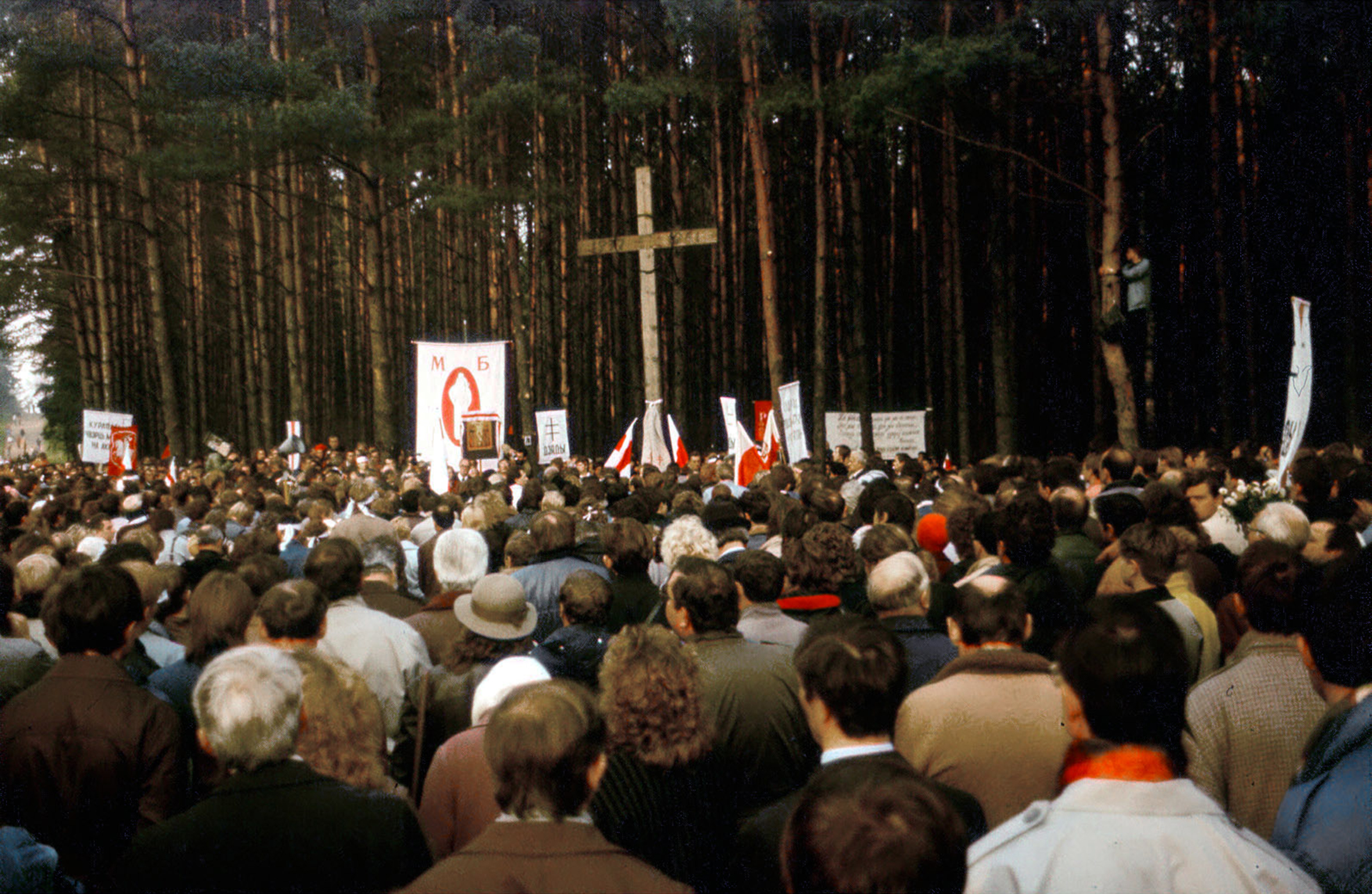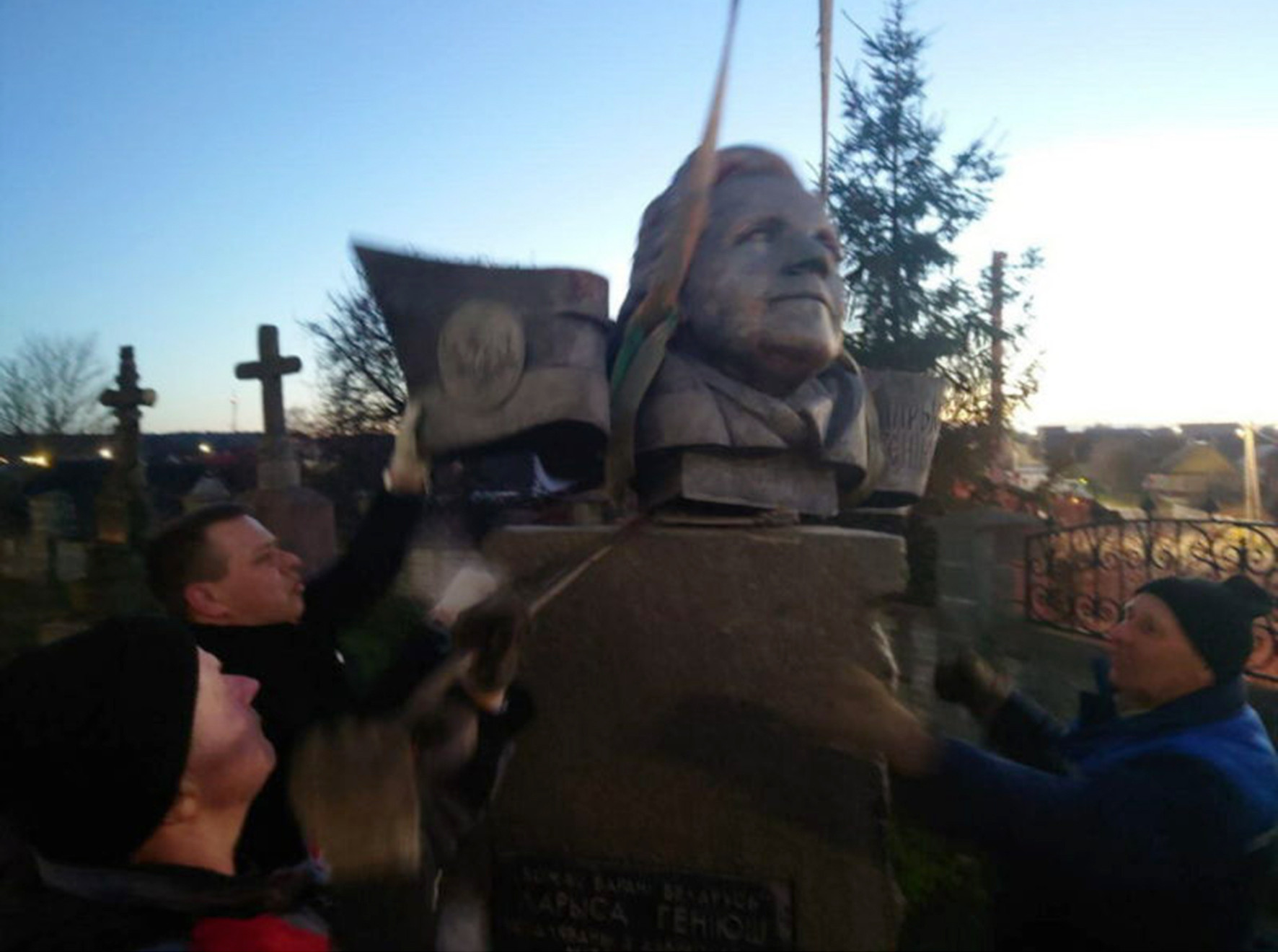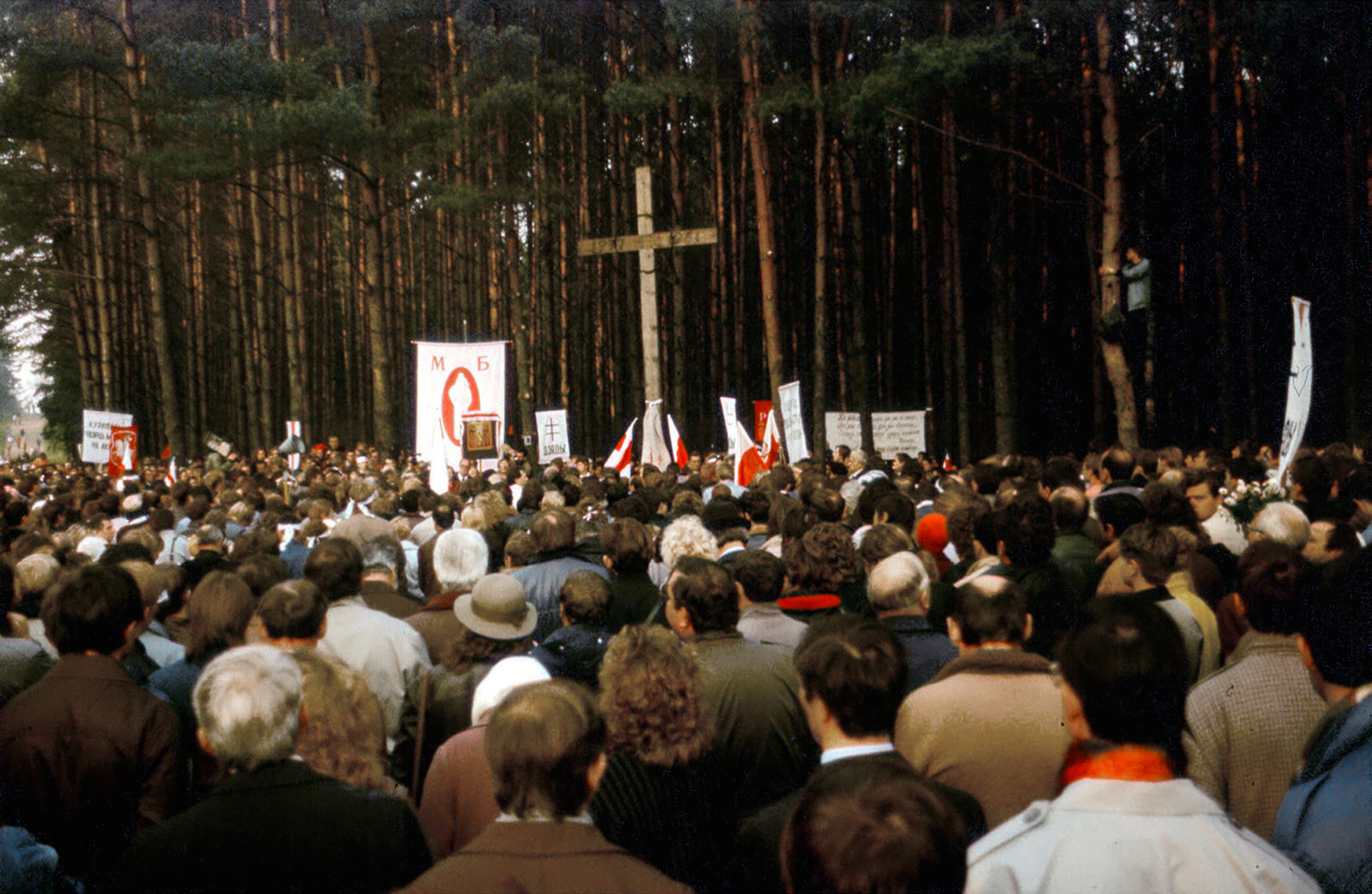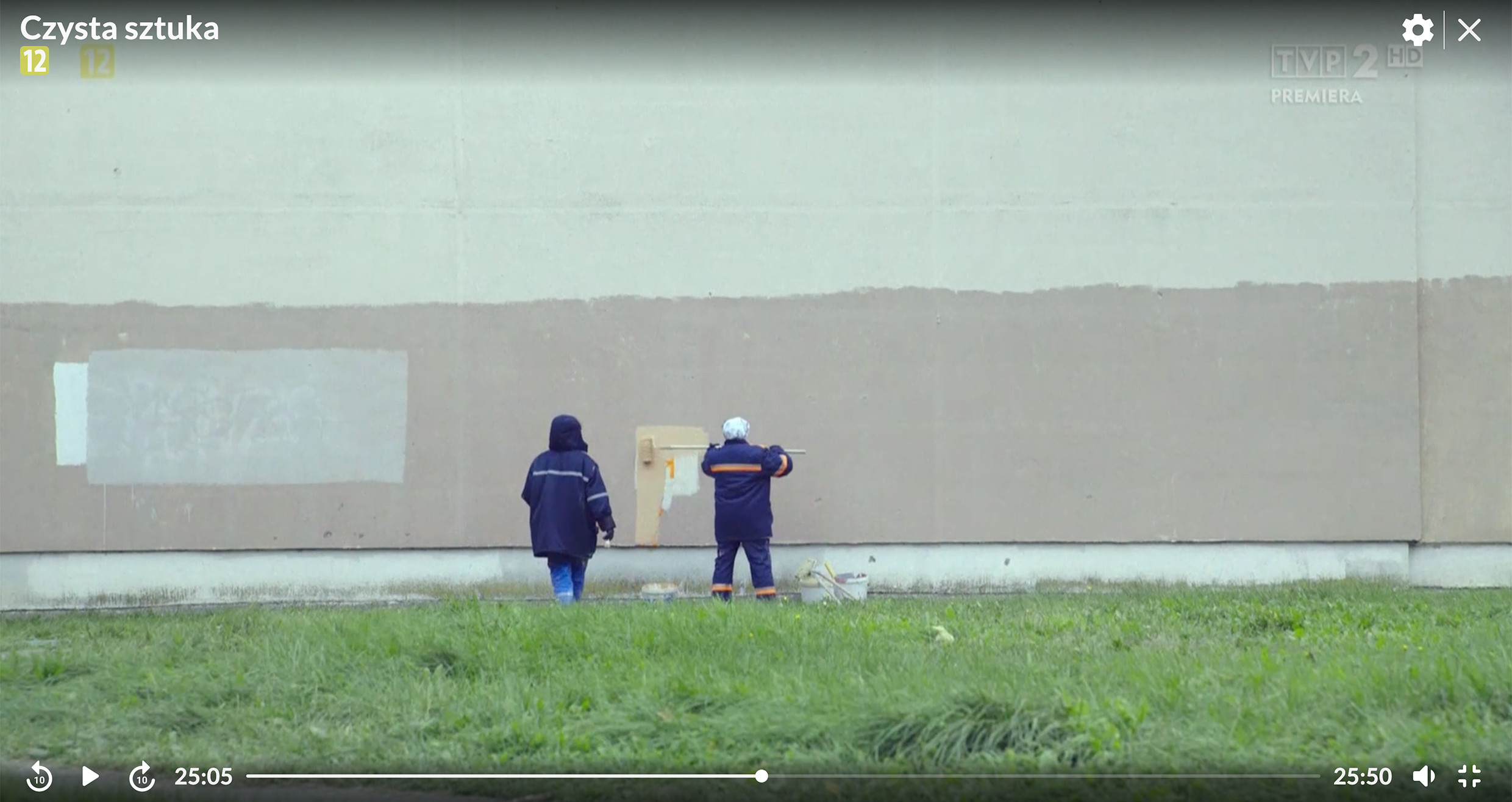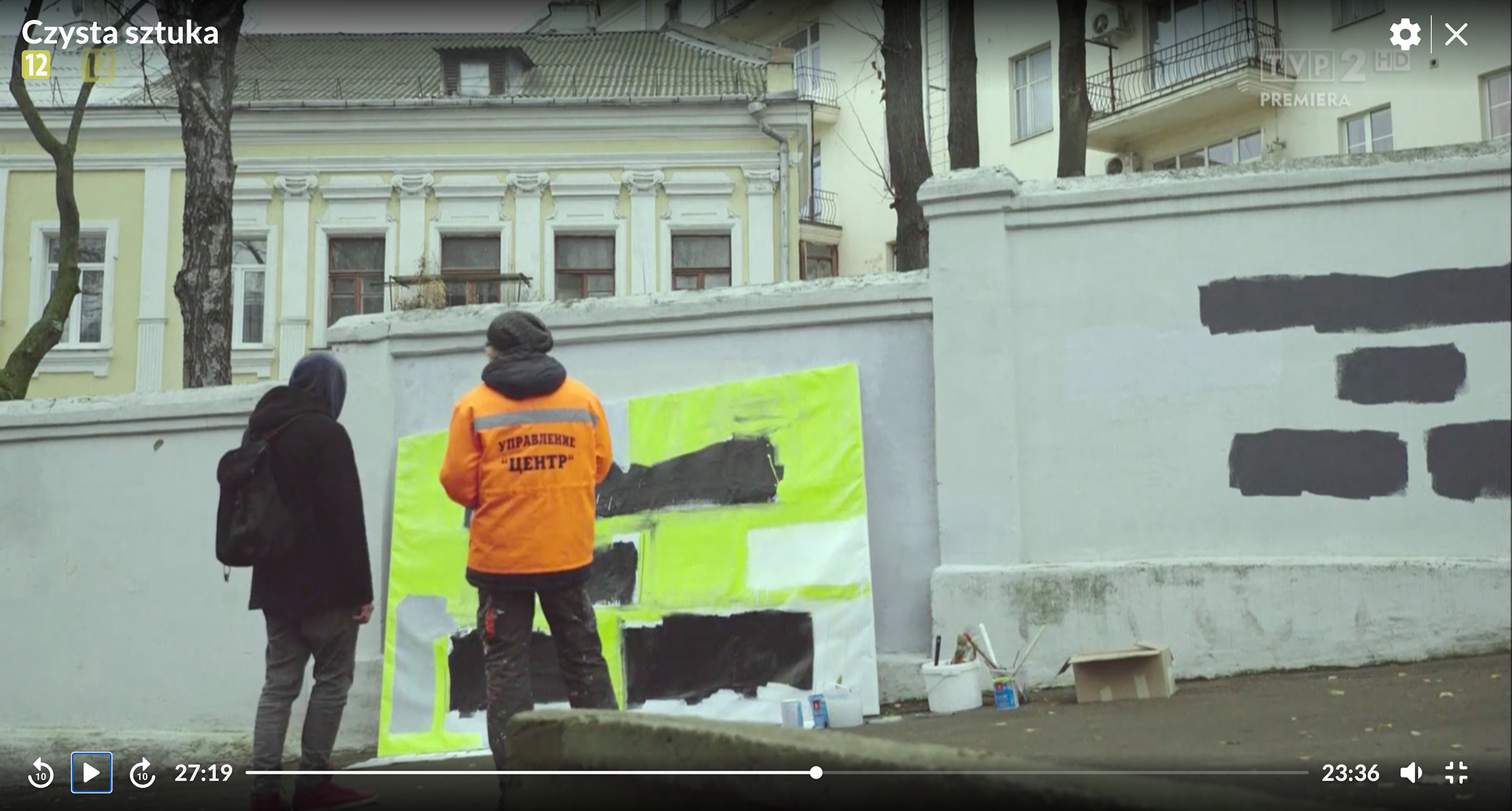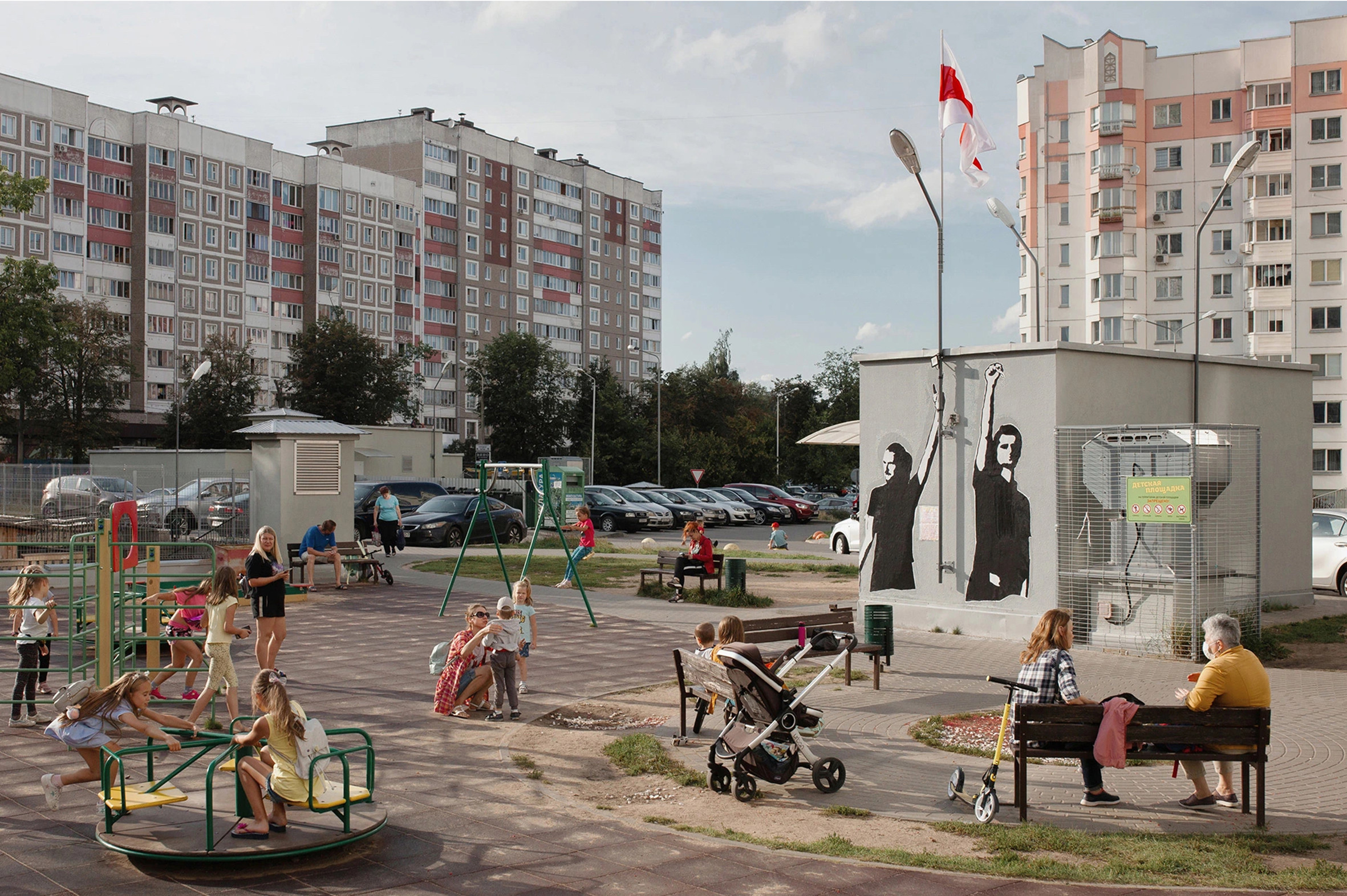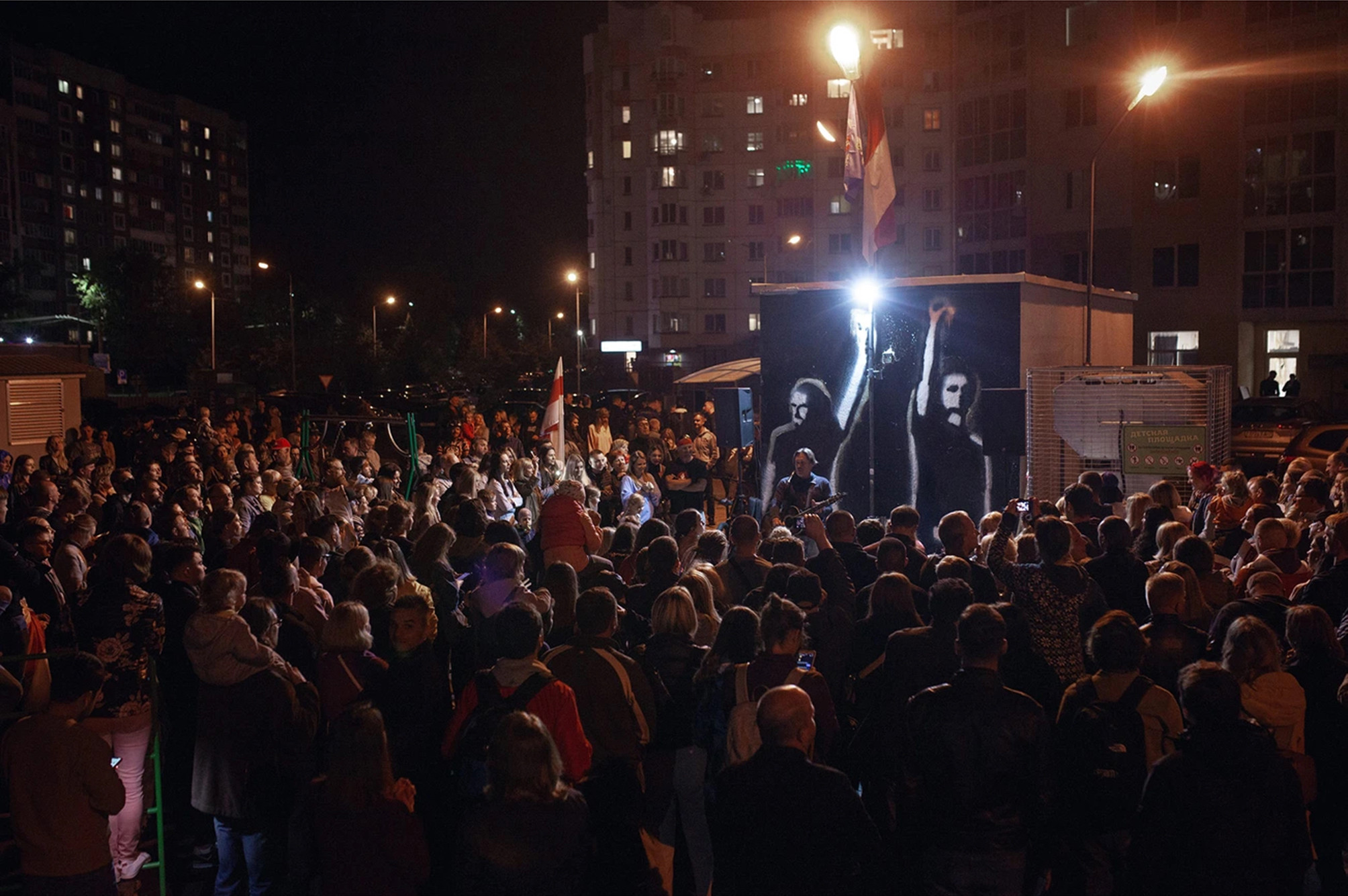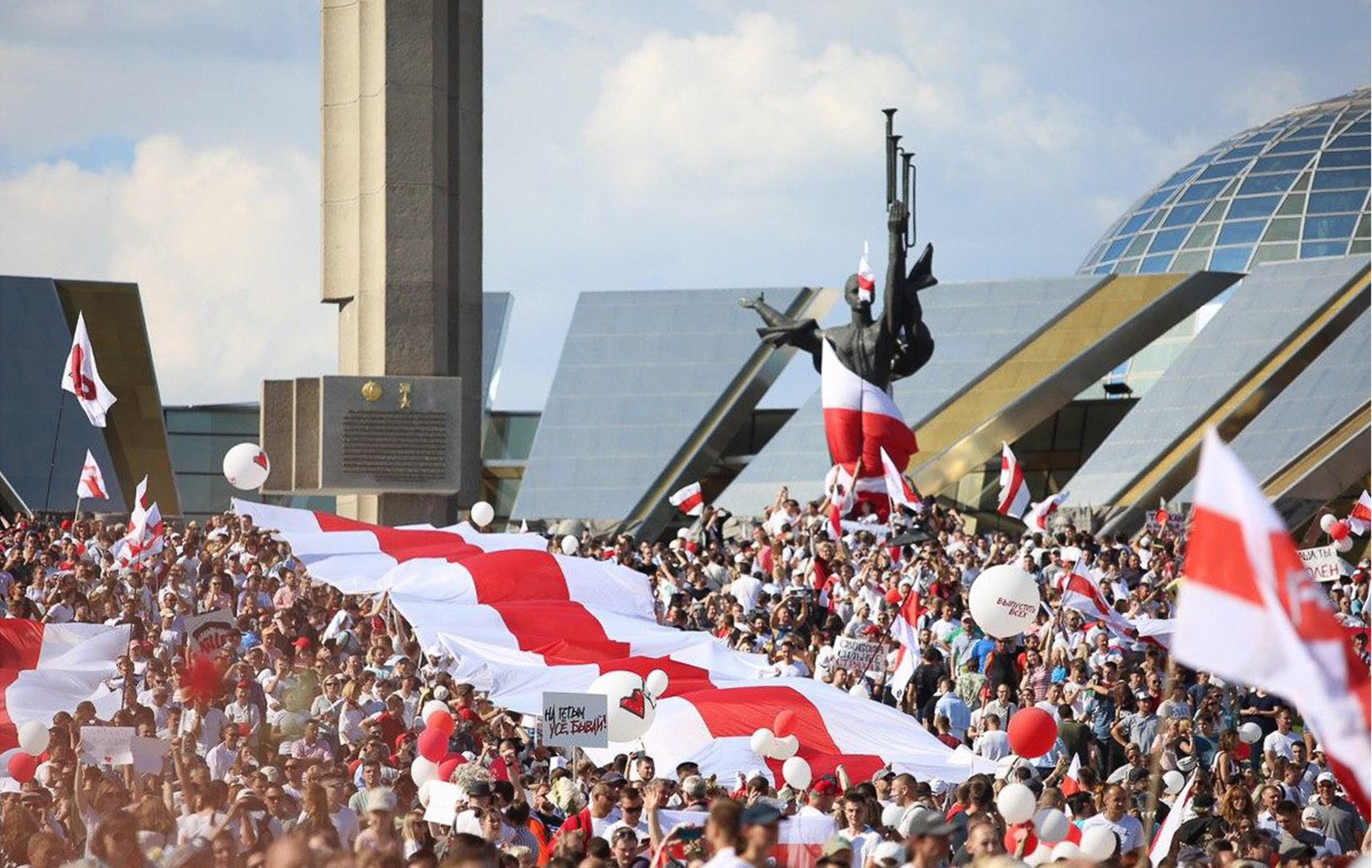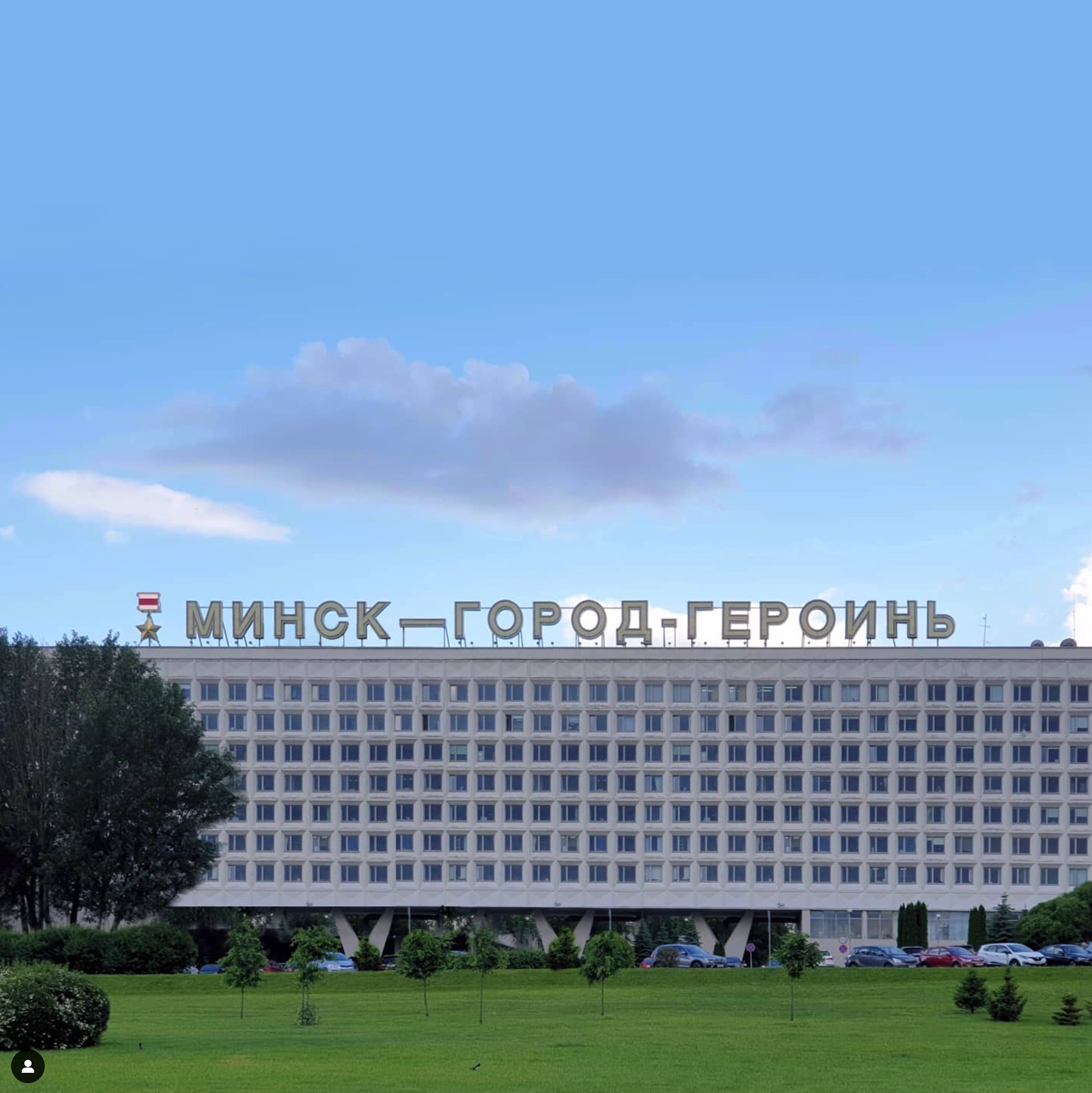On the night of March 29, 2023, a strange event happened in a small town in Belarus—a large concrete monument dedicated to one of the few 20th-century national female poets disappeared overnight. Nobody seemed to know what happened and whose responsibility it was until a video of communal city workers demounting it in the middle of the night resurfaced in local Telegram channels a few days later. What seemed to be a prank gone astray was an event symptomatic of the anxious desire of the contemporary Belarusian state to actively revise its historiography and physically erase any, even remote, references to historical events that are misaligned with the accepted current. While the idea of managing collective memories through acts of destruction is not new, the case of contemporary Belarus is exemplary in this regard. In its pursuit of sterile urbanscapes, the state continues to employ the long-and-tried Soviet techniques of brute destruction. However, these acts of intentional destruction are rendered increasingly less potent as they are covered in online media, steering wide public debates around the nature of urban heritage and preservation. This paper then argues that acts of heritage destruction are also generative, as they create new intangible memory marks that define the city's symbolic and lived experiences through this intentional absence, much more so than through the previously accidental presence.
If heritage and collective memories are ultimately political concepts, then acts of targeted heritage destruction can be equated with acts of political oppression. The process of memorization then becomes resistance, which, in the words of Milan Kundera, is the “struggle of memory against forgetting.” The essay is particularly interested in the generative effects of state-sanctioned destructions. New collective identities are forged against the act of destruction and find their definition through the absence. Through a collection of case studies of contemporary Belarusian urbanscapes—from a make-shift memorial to the victims of Soviet repressions to acts of censorship on city walls and the intensive struggle over a mural in a housing courtyard—the essay explores how different shared memories and collective identities are forged in opposition to the acts of destruction. In the cycle of destruction and creation, successive bids to power generate new ideas, contributing to the growing national consciousness and expanding horizontal networks of citizenship and solidarity. However, despite these “productive” effects of destruction dialectics, these newly fostered identities have a limited temporal horizon without tangible heritage. As their embodiment is denied, new memories are forced either to adapt to other vessels and sites of memory or ultimately disappear.
The first step in liquidating a people is to erase its memory. Destroy its
books, its culture, its history. Then you have somebody write new books,
manufacture a new culture, invent a new history. Before long,
the nation will begin to forget what it is and what it was.
Milan Kundera1
On the night of March 29, 2023, a strange event occurred in the small town of Zеĺva in the west of Belarus. A large concrete monument dedicated to Larysa Hienijuš, one of the few 20th-century national female poets and activists who actively opposed the Soviet regime, disappeared overnight2. Nobody seemed to know what happened and whose responsibility it was. Numerous calls to the local town hall revealed that, despite the protected status of the monument, state officials seemed clueless about its whereabouts and had little interest in figuring it out. Queries redirected to the local Orthodox church that originally installed the monument returned with no response, and clergy officials seemed equally puzzled about what happened to the modest sculpture. Eventually, a video of communal city workers demounting it in the middle of the night resurfaced in local Telegram channels a few days later (fig. 1)3. When local activists offered to pay a ransom for the kidnapped monument, state representatives conveyed that it “was not for sale” and, quite cryptically, that the memorial was “with its owner, where it needed to be”4.
It turned out that the sculpture fell yet another victim to the notorious pro-Russian activist who argued it “imposed immense sufferings to the veterans of WWII” and “tainted the bright name of the Belarusian Orthodox Church”5. Despite the ontologically contradictory implications of these claims, town hall officials decided to act upon them, albeit discreetly. However, even with the best efforts to conceal the covert kidnapping, the disappearance of a monument to one of the very few female poets and symbols of national revival did not go unnoticed and caused a heated public debate on the role of memory, heritage and preservation. Hienijuš’s grandson, who lives in exile in Poland, commented: “Monuments can be removed, but what is in people's hearts, no one will take away”6. What seemed to be a prank gone astray was an event symptomatic of the anxious desire of the contemporary Belarusian state to covertly revise its historiography and physically erase any, even remote, references that are misaligned with the accepted narrative of the recent history.
The idea of actively managing history and collective memories through acts of physical destruction is not new. As cultural scholar Andreas Huyssen argues, individuals and societies construct their identities and future visions through anchors in the past7. The memorialization process is complex and multifaceted, but collective memories are not permanent, defined through the complex interlinked process of remembrance and forgetting. Despite the perception of cultural memory as something ephemeral, as heritage scholar Veysel Apaydin argues, it is closely tied to tangible heritage and material culture and cannot exist without it8. Buildings, particularly sacred and shared spaces, form locations where different social groups can come together, share experiences, forge traditions and invent collective identities9. Monuments and architectural heritage become sites of self-identification and containers of memories, which, in turn, could be moulded and adjusted through acts of selective preservation and destruction.
In his book, The Destruction of Memory: Architecture at War, Robert Bevan argues that precisely the architecture’s impression of permanence—the physicality of bricks and stone—makes manipulation of architectural heritage so enticing10. By erecting or taking down sites of memory, political elites select the preferred version of history and establish historical incidents that define formative points of the nation’s history11. Heritage, as a container of cultural memory, is, ultimately, a political concept that has been used (and abused) to shape and oppress communities whose collective memory contradicts the current power structures and versions of history12. Destruction of tangible heritage often becomes an instrument of oppression applied to erase a group's identity and prevent that group from developing and creating new heritage and memories. In a similar way, as George Bataille remarked, it is not just that monuments symbolise the enemy, but they are, in themselves, the enemy13. Tangible heritage then plays a vital role in memory and forgetting and is instrumental in “the struggle of man against power”, which Milan Kundera defined as “the struggle of memory against forgetting”14.
The essay then explores various claims to power within the dualistic cycle of heritage destruction and creation and their effect on the multifaceted process of remembrance and forgetting. Through several case studies from the recent history of Belarus, this essay investigates the generative impact of the acts of heritage destruction. Urban scholar Andreas Huyssen extensively researched “the voids of Berlin,” which are a testament to the many historical ruptures and successive bids for power15. And if Berlin is trying to come to terms with its memory through simultaneous voids and ruins, presence and absence, urban landscapes in Belarus struggle to remember as they continue to be defined by forced absences and absent records of past destructions. I argue that premeditated state-led acts of heritage destruction in Belarus often generate new memories against the absence of what has been. New collective identities are then forged against the act of destruction and find their definition through the absence. However, despite the “productive” effects of these destructive dialectics, newly fostered identities have a limited temporal horizon without tangible heritage sites. As their embodiment is denied, these memories are forced to adapt to other vessels and signs of memory or ultimately disappear.
Acts of iconoclastic heritage destruction are not new, as, according to Edward Said, historical memories are frequently manipulated for “urgent purposes in the present”16. Many would recall video recordings from 2013 in Ukraine depicting a dense crowd gathered around a statue in a central city square, cheering, screaming, and filming. As the figure is ejected from the pedestal—suspended in the air by a crane or toppled forward with ropes—the crowd rushes forward, trying to get a piece of its soon-to-be dismembered body17. These statutes of Vladimir Lenin have been ubiquitous in cities across Eastern Europe for nearly a century. In the last ten years in Ukraine, over 5,000 sculptures were taken down through a grassroots process deemed “Leninopad”—literally a “Lenin-fall”18. The fate of Soviet sculptural heritage today is inconsequential in the context of the full-scale Russian invasion of Ukraine. However, this case of serial destruction is particularly interesting because of the symbolic role the sculptures maintained in the process of Ukrainian revision of its recent past19. The displacement of the statue into a bizarre, out-of-the-ordinary position and its shuttering seemed to be an act of revenge against years of authoritarianism that threatened one’s bodily integrity. Owning a dismembered body part of the former idol turned into a fetish—so much so that fragments of Lenin statues today are impossible to trace, as they are scattered into myriads of private collections20. The former concrete pedestals have been painted in the colours of the Ukrainian flag but often remain unoccupied, slowly deteriorating, framing the ideological void left in the absence of what has been21. This case of heritage revision in Ukraine is significantly different from Belarus: despite applying the same techniques of destruction inherited from the Soviet past, these voids are left precisely by the plurality of future potentialities. In Belarus, a country that not only vigilantly protects its Soviet heritage but maintains a museum of Lenin sculptures, possibilities for rethinking the Soviet past are limited to the liminal parts of the urbanscape22.
The Soviet state had always maintained a pro-active position managing tangible and intangible heritage: Minsk, a former gubernatorial city and, since 1920, the capital of the Belarusian Soviet Socialist Republic, had lost many sites of memory as the new state ideology was anxious to assert its presence through targeted acts of destruction. Already in 1936, the Church of the Holy Spirit—the oldest Renaissance church in the city—was blown up in pieces, and the same was the fate of many other of the city’s religious and cultural landmarks23. Destruction of cultural memories was not limited to the urban fabric. Following a brief period of “belarusisation,” the new Soviet state mounted a terror campaign against cultural institutions and professionals that researched and promoted national heritage. From 1937, all Soviet republics endured a wave of severe repressions that primarily targeted cultural and political elites24. In Minsk, mass executions happened in Kurapaty, a large piece of forested land in the city's northern suburbs, established as a city park in 1934. While the scale and horrid history of these events are far beyond the scope of this essay, this site—and more specifically, its absence in the official historical narratives and the powerful generative impact of such absence—are particularly relevant for the intentions of this essay.
The public “discovery” of the site happened in 1988 when archaeologist Zianon Paźniak and engineer Jauhien Šmyhalioŭ published an article in the Belarusian literary newspaper Litaratura i mastactva25. The article drew from the interviews with eyewitnesses of the mass killings and the results of a brief archaeological investigation. Estimating the number of victims between 30,000 and 250,000, the article caused a broad public debate, and several state investigation committees were set up26. Despite the “discovery” of the late 1980s, the site was well-known to the residents, who maintained first-hand harrowing memories of the events; several graves were found already in 1957 during the construction of the city ring road and again during the works on the city gas line in the 1980s27. Quite obviously, no official memorialisation was possible during the Soviet time. However, the public discovery of the site in 1988, at the dawn of the Soviet era, and its deliberate absence prompted the first large political rally demanding that a tangible memorial be installed. This rally turned not only into an annual tradition to commemorate the victims but also provided one of the central setting stones of the post-Soviet Belarusian national identity28. A year later, the second rally was brutally suppressed but led to the creation of the Belarusian Popular Front, a prominent opposition party headed by Paźniak (fig. 2). The party’s ideology was centred around the anti-communist reading of Belarusian history, in which the Kurapaty memorial site was seen as a locus of a different historical narrative and resistance to the Soviet past29.
Throughout the early years of independence, the site maintained its instrumental role in constructing new national narratives. According to Nelly Bekus, a scholar of post-Soviet memory studies, Kurapaty became a “lieu de mémoire for the Belarusian nation, a sanctuary of Belarusian martyrdom,” also dubbed as “the Belarusian’s Golgotha”30. Famous Belarusian writer Vasil Bykaŭ called Kurapaty “a shared sacred symbol” for the historical memory of Belarusians31. Every year, memorial rally participants carried makeshift wooden crosses to install in the woods, with iconography explicitly referring to national martyrdom. In 1994, Bill Clinton visited the site, and the US embassy installed a modest commemorative concrete bench as a sign of sympathy and respect.
Since the 1994 autocratic turn in Belarusian politics towards a regime that emphasises the continuity with the Soviet past, the physical integrity of the Kurapaty memorial, a symbol of national revival, has been a site of continuous contestation and targeted acts of destruction. The site was threatened several times: in 2001, a new passage of the beltway road was planned through the site, prompting wide social mobilisation and large (but unsuccessful) protests. Similar confrontations followed in 2011, 2014 and 2018, and the site itself (as well as Clinton’s bench) had been vandalised many times32. This makeshift memorial on the site of mass repressions offers an example of memory re-installed in the absence of tangible heritage. The discovery of this absence triggered a chain of generative events, which resulted not only in a new (albeit impermanent) site of memory but also contributed to shaping a new collective identity. Post-independence Belarusian national identity, in a way, grew out from and was defined by this absence.
Today, the memory of Kurapaty is still absent in the official discourse. However, this resistance to acknowledging the site of memory and continuous attacks on its whimsical presence continue to sustain collective identities forged against the acts of memory destruction. Unlike the Ukrainian process of de-Sovietisation that relied on tangible methods of physical erasure and replacement, in Belarus, this process was moulded by the increasingly diminishing political space. In these circumstances, Belarusian activists had to adapt more subtle strategies of memory instalment and appropriation. Similar to populating the seemingly empty forested site with provisional wooden crosses to commemorate the victims, each act of state-led destruction repopulated landscapes of Belarusian identity with shared but transient cultural memories.
This intangibility of collective memories in the face of state-led destruction reached an all-time high with a wave of popular protests that swept Belarus following the falsified elections on August 9, 2020. Millions of Belarusians poured onto the streets across the country, demanding their voices be heard. Thousands of people lined for kilometres in “solidarity chains” along the grand Stalinist-era boulevard in Minsk. The usually empty Soviet-planned city centre suddenly bustled with people while the front steps of “People’s Palaces” staged viral solidarity performances. Leaving the house, one would be invited to a children’s workshop, a tea-drinking party or an evening concert in the courtyard of a panel housing block. Initially stupefied, the state responded with unprecedented levels of violence. As police brutality increased, civil society continued to affirm their presence through solidarity actions and graffiti that appeared across the city, driving zealous state maintenance teams insane. From large stipes of white-red-and-white colours to poems and inscriptions, the walls of Belarusian towns were made to speak. At the task of the state, municipal services laboured day and night to cover the signs of dissensus with patches of pastel rectangles, following a decades-long tried-and-true sanitising strategy of the state obsessed with the images of urban sterility and cleanliness.
Seemingly innocent pastel-coloured patchworks that seemed to propagate on Minsk walls overnight were, in fact, practical tools to silence political opinions. Perfected over the last decades, this physical destruction of political expression was conceptualised by Belarusian cultural theorists as "fu-prematist" art, a definition referring both to the ubiquitous nature of these coloured rectangles and their shared conceptual lineage with the suprematist art of the early 20th century33. In 2019, Belarusian film director Maksim Shved dedicated an entire documentary film titled “Pure Art” to the critical investigation of these successive acts of destruction 34. The film follows two storylines: a Belarusian contemporary artist, Zahar Kudin, who carries a large canvas around the city, engaging the passers-by in heated discussions around the role of contemporary art and censorship, and the team of municipal workers as they labour to cover expressions of dissent. “The main task of the artists is to interact with the environment,”—Kudin is recorded saying just five minutes into the film35. Kudin paints the canvas with the same pastel palette used by the municipal workers and often mimics the existing censorship patchwork. He also wears a bright orange vest in reference to city workers’ uniforms. The two municipal office workers are also filmed while covering signs of dissent around the city. One of the signs reads, “Belarus is my country,” and the two women are recorded contemplating it. “There is nothing bad about it,”—comments one, but proceeds to colour the note with a green rectangle a shade darker36. In another shot, they are captured solemnly painting over the word “beauty” (fig. 3)37.
Without exerting judgment, the film offers a unique insight into a continuous cycle of creation and destruction. The state-initiated destruction is not always effective: workers operate on a task without much personal investment and with cheap materials. The paint withers quickly, making original messages easy to decipher. Original authors—people set on having their voices heard—invest in good-quality paint and often return to reinstate their message. Sometimes, others develop on the original writing, joining forces against the municipal workers in an endless battle of dissent and destruction. Akin to Malevich’s Black Square, founded on creation in the place of pictorial destruction, Minsk city walls stage a multi-contextual visual between the citizens and the state38. The event of destruction creates new meanings, as the original message often remains readable and understandable in its destruction. This becomes particularly obvious in the film when Kudin tries to depict the previous act of destruction by replicating black censorship rectangles from the urban wall on his canvas. Within minutes, his painting is seized by the special police forces that find the representation of destruction a subversive act in itself (fig. 4)39. The destruction of the painting and detention of Kudin then marks the merger between the two storylines of the film, as Kudin is recorded in conversation with municipal workers about acts of deliberate censorship and pictorial destruction.
This battle for layers of urban memory reached an all-time high in the autumn of 2020 when tragic real-life effects rippled far beyond the two-dimensional pictorial surface. The events unfolded in a courtyard of one of Minsk’s new housing estates, which became known as Plošča Peramen or “the Square of Changes”40. The Square (or, more precisely, an internal semi-public courtyard) took its name from a new mural that appeared in August 2020 on a technical ventilation box. A local street artist painted two DJs who became early symbols of civic resistance as they played the informally prohibited 1986 rock song “Changes” during an official city event earlier that month41. The next day, a grey rectangle appeared over the mural, to be revived by the residents, then destroyed again with black resin that would prevent new layers of paint in the future42. Yet, the mural was washed out again, covered in grey paint and remade, vandalised with red lettering and painted over again and again. Overall, there were more than twenty back-and-forth cycles of destruction and creation of the mural (fig. 5)43. How could something so whimsical as a glued-on paper mural on a random ventilation box pose so much threat?
The mural’s content did not matter, but its symbolic presence gave rise to a new shared collective identity of the housing block residents. As the dwellers recalled, they hardly knew each other names until the Summer of 2020—referring to the lyrics of yet-another rock song44. The violent acts of destruction constructed a shared experience of the state overstepping its boundaries and reaching into a private realm. In the place of destruction, collective acts of re-making were equated with popular resistance, consolidated through the invention of new shared traditions. The mural provided a backdrop for rock and folk music concerts, professional theatre plays, children's performances, lectures, photoshoots, football games, craft fairs, dance workshops and tea-drinking parties (fig. 6).
In practice, it became not only a lieu de mémoire—a place of communicative memory for the residents but also a “vernacular landscape” created by individual citizens against the state's narrative45. This memory was not abstract: it rested on new rituals and collectively developed material artefacts which, expanding on the Lacanian mirror theory, allowed the individuals to recognise themselves as a part of a wider community. Similar to the Kurapaty memorial, a new collective identity grew from the forced absence, but even this vaguely defined community with a temporary memorial seemed to threaten the state narratives.
State officials realised the importance of creation to counteract the Square’s material heritage. For example, thousands of the small white-red-and-white ribbons tied on the fence by the residents were replaced overnight with the “official” state colours by unidentified people supervised by the police. “Positive” messages favouring the regime were re-inscribed over the mural. Tension around these dualistic acts of destruction and creation intensified when, on September 15, 2020, one of the local activists—Stsiapan Latypau—was violently detained as he was protecting the mural46. On November 11, another local activist and artist, Raman Bandarenka, was killed over a confrontation with undercover state officials on a mission to destroy any visual signs of dissent47. This death triggered the creation of a new impromptu memorial around the former mural, followed by yet another large wave of protests and violent conflicts, more iterations of the mural, and eventually, tragic disappearances of residents, activists and journalists and very long criminal sentences48. In November 2020, Bandarenka’s memorial was violently destroyed by special police forces, leaving a profound void, a memory of absence left within the local community49.
The Square was just one of the many places where similar developments occurred: the growing sense of urban ownership manifested in different scales and formats across Minsk's urban spaces. For example, at one of the biggest rallies, the 1985 bronze figure of “Motherland,” generally considered a void signifier of late-Soviet stagnation, was wrapped in a gigantic white-red-and-white flag. As thousands of images of the sculpture circulated online, it became clear that the collective memories attributed to the place had been re-coded. Backed up by the Soviet-time lettering “Minsk is the hero city,” thousands of peaceful protesters who demanded justice in the face of senseless violence seemed to be the new heroes of the times, re-inscribing new meanings into former Soviet clichés of patriotism and motherland (fig. 7)50.
Consequent protest rallies named Marches of Victory, Heroes, Unity, Solidarity and Partisans were arranged every Sunday throughout the fall, borrowing the formal terminology of the Soviet propaganda and creatively adapting it to the needs of the time51. Through shared collective experiences during these multi-thousand-people protests, buildings and urban landscapes became entrusted with new meanings52. However, as the pressure from the state increased, organised collective actions and any symbols of dissent became increasingly dangerous.
French historian and memory scholar Pier Norá expanded on the argument of philosopher Maurice Halbwach, discussing the role of oral memory. Norá argued that any memorialisation process requires a network of symbols, values, rites and local traditions to transform a collective memory into a memory of the nation53. Shared memories are maintained through a multiplicity of circulating images and semiotic processes that enable their entextualisation54. To be sustained, however, these memories need to find durable carriers of external symbols and representations, visual and verbal signs as aids of memory—otherwise, they disappear55. In the diminishing political space, collective ritual actions which fostered the shared identity of Belarusian protesters—like the Sunday marches, not a far-off allusion to the political ritual substituting a religious one—were gradually phased out56. Without the commemorative rites that reactivated the memory and enhanced collective participation, the development of shared identity became increasingly more complex. Thousands of photographs and videos of protest actions had to be taken from the public realm and private archives so as not to endanger the participants. In the increasingly liminal space, any visual commemoration—even virtual mapping of the memory of the events—was denied57. So how could collective memories and, as a consequence, shared identity continue to exist in the denial of any tangible physical heritage?
This essay, somewhat as a provocation, suggests that in the diminishing political space, new shared memories of collective resistance had to be encoded into the existing urban fabric. The pompous Soviet inscriptions ubiquitous throughout the city referred to the acts of heroism during the Second World War. Now, these signs could be re-coded, supplemented with new signifiers referring to people’s heroism and solidarity in the wake of the state’s oppression. And while the Belarusian state laboured zealously to conceal any visual symbols of dissent, these monumental signs could not disappear. This lettering, part of the “sanctioned” urban history, operated in a liminal space, channelling what anthropology scholar Jackie Feldman defined as a “two-way traffic between the past and the present”58. As explored by Robert Bevan in Architecture at War, such transfer could also be read through the lens of Derrida’s “dangerous supplement,” where any representative image claims to be both the presence and the sign of the thing itself, “whose cohabitation is as strange as it is necessary”59. A new meaning is added to the existing one, enriching the plenitude: “compensatory and vicarious, the supplement in an adjunct, a subaltern in stance with takes-(the)-place”60. Official sites of memory and commemorative inscriptions then become containers of new meanings and history—and there is little the state can do to counteract such development since, in the words of Derrida, “the sign is always the supplement of the thing itself”61. Indeed, as cultural anthropologist Peter Nas maintains, any commemorative symbols have a polyvocal nature, as “they often possess an official meaning bearing the intentions of the creator in mind, but informal references may be attached to them, enforcing, neutralising and even counteracting the original intention”62. Through successive dialectical bids for power, official memorials transform into sites of resistance within the condition of increasingly diminishing political space.
Today, no tangible heritage or physical memories of the protests are visible in the public urban landscape. However, that which is no longer there maintains a strong symbolic presence even in the deliberate absence, not least among thousands of families directly affected by the events63. Traces of the protest symbols can still be detected in the backstreets, alleys, courtyards, and remote parks, faintly visible in the washed-out and sun-dried painted rectangles. Contemporary Belarusian artists maintain collective memories of the events, investigating the role of urban memorials, albeit in a virtual space (fig. 8).
Unlike the case of Ukraine, where monument destruction left temporary voids to be re-installed with new meanings, in the case of Belarus, there is no physical space to commemorate the resistance. In the diminishing political space, collective memories have to be re-coded into the existing urban landmarks, descendants of previous destructions. However, as the cases from the essay aimed to show, acts of destruction are never terminal. Instead, they trigger a cycle of successive bids for power, where new potentialities become possible. Some of the ideas at the heart of post-independence Belarusian identity grew from the historical voids, from the forced destructions of sites of memory and cultural heritage.
Similarly, new memories and collective identities of Belarusian solidarity were formed in 2020 as a reaction against the state-sanctioned acts of destruction. However, these identities cannot survive for several generations without sites of tangible heritage where memories could be “accumulated” and “performed.” Following Kundera’s roadmap, in their fight against oppression, Belarusian civil society has some—albeit limited—time to figure out how to maintain these shared memories in absentia, in lieu of destruction.
notes
Kundera, Milan. 1988. The book of laughter and forgetting. London: Penguin Books.
2023. “Zelva Memorial Was Demolished.” Nasha Niva, March 30, 2023. Accessed May 20, 2023. https://nashaniva.com/313282.
2023. “Who Stole the Monument to Larysa Hienijuš?” Novy Chas, April 5, 2023. Accessed May 20, 2023. https://novychas.online/hramadstva/hto-i-navoszta-shavau-pomnik-laryse-henijusz.
2023. “A Monument to Larysa Hienijuš Has Disappeared.” Svaboda, March 30, 2023. Accessed May 10, 2023. https://www.svaboda.org/a/32341785.html.
2023. “Volha Bondarava is After the Hienijuš’s Monument.” Nasha Niva, March 31, 2023. Accessed May 10, 2023. https://nashaniva.com/311404. On the ambiguous role of Belarusian churches in the recent political turmoil see Borowska, Paula. 2021. “Christian churches, social capital and the 2020 Belarusian uprising.” UCL blog (August 9, 2021). Accessed May 20, 2023. https://blogs.ucl.ac.uk/ssees/2021/08/09/christian-churches-social-capital-and-the-2020-belarusian-uprising/.
2023. “Monuments Might Disappear, but Not the Memories.” Novy Chas, April 8, 2023. Accessed May 10, 2023. https://novychas.online/kultura/unuk-larysy-henijusz-pomniki-mozna-prybrac-ale.
Huyssen, Andreas. 1994. Twilight Memories: Marking Time in a Culture of Amnesia, New York: Routledge, 249.
Apaydin, Veysel. 2020. "The interlinkage of cultural memory, heritage and discourses of construction, transformation and destruction." In Critical Perspectives on Cultural Memory and Heritage. Construction, Transformation and Destruction, California: UCL Press, 16.
Bevan, Robert. 2006. The Destruction of Memory: Architecture at War, London: Reaktion Books, 24.
Ibid.
Johnson, Nuala. 1998. "Cast in Stone: Monuments, geography, and nationalism." Society and Space 13, no. 1: 51-65. Cosgrove, Denis E. 1998. Social Formation and Symbolic Landscape, Madison, WI: University of Wisconsin Press. Levinson, Sanford. 1998. Written in Stone: Public Monuments in Changing Societies, Durham, NC: Duke University Press.
Apaydin, Veysel. 2020. Op. cit., 17.
Bevan, Robert. 2006. Op. cit., 35, referring to Bataille, Georges. 1992. "Architecture." In La dictionnaire critique, Paris: L'Écarlate.
Kundera, Milan. 1988. Op. cit.
Huyssen, Andreas. 1977. "The Voids of Berlin." Critical Inquiry 24, no. 1: 58.
Said, Edward. 2000. "Invention, Memory, Place." Critical Inquiry 26, no. 1: 179.
See, for example, a compilation video from 2014. “Leninopad on Hromadske.” Hromadske, February 22, 2014. Accessed August 20, 2023. https://www.youtube.com/watch?v=DdBTG7PBcDw&ab_channel=hromadske.
2023. "Lenin Falls." Digital Atlas of Ukraine, Ukrainian Research Institute Harvard University. Accessed August 20, 2023. https://gis.huri.harvard.edu/lenin-falls.
Gaidai, Oleksandra. 2021. "Leninfall in Ukraine: How Did the Lenin Statues Disappear?" Harvard Ukrainian Studies 38, no. 1/2: 50-60.
See an exhibition curated by Kochubinska, Tatiana. 2015-2016. "Let’s put Lenin’s head back together again!" Pinchuk Art Centre, Kyiv, Ukraine. Ackermann, Niels, Gobert, Sébastien. 2017. Looking for Lenin, London: Fuel.
2018. “Leninopad of 2014 had left thousands of concrete pedestals.” Ukraiina TV, January 18, 2018. Accessed August 20, 2023. https://www.youtube.com/watch?v=S5-v7R8vzeE&ab_channel=%D0%A1%D0%B5%D0%B9%D1%87%D0%B0%D1%81.
Azgur Museum in Minsk, Belarus, stores a large collection of Lenin sculptures produced by a prolific Belarusian artist Zair Azgur. See a virtual tour of the museum's main sculpture hall online at Google Arts and Culture. "Excursion at the Museum." Accessed August 20, 2023. https://artsandculture.google.com/story/SgXBPJUxXyI_zg.
Pazniak, Zianon. 1985. An Echo of Old Times, Minsk: Narodnaja Asveta, 60. Balazhunski, U.G. 2007. “Minsk Old and New”. In Minsk, edited by Zachar Šybieka, Minsk: Harvest, 68. Winnicki, Zdzisław J. 2005. Szkice kojdanowskie, Wrocław: Wydawnictwo GAJT, 77-78.
See original documents by Kuzniacoŭ, Ihar. 2016. "Repressions against Belarusian intelligencia and peasants, 1930-1940." Online lecture at Belkalehium, April 10, 2016. Accessed August 20, 2023. https://belcollegium.com/igar-kuznyaco%D1%9E-represii-suprac-belaruskaj-inteligencyi-i-syalyanstva-u-1930-1940-gady-lekcyi-1-2/.
Pazniak, Zianon. 1988. "Shumiats nad mahilai sosny." Litaratura i Mastactva, (June). See English version at Paźniak, Zianon, Šmyhalioŭ, Jauhien. "Kurapaty—the Road of Death." Accessed August 20, 2023. https://knihi.com/Zianon_Pazniak/Kurapaty_-_the_road_of_death-eng.html.
Paźniak, Zianon. 1993. Kurapaty, Minsk, 66–68. On the committees and debates on the estimates, see Marples, David R., and Veranika Laputska. 2020. "Kurapaty: Belarus’ Continuing Debates." Slavic Review 79, no. 3: 523-530.
Paźniak, Zianon. 2018. "Ab kolkaści zabitych u Kurapatach." Narodnaja pieramoha, June 27, 2018.
Dubaviec, Siarhei, ed. 2002. Daroha praz Kurapaty, Minsk: Radio Free Europe/Radio Liberty, 98.
Marples David R., Laputska, Veranika. 2020. Op. cit., 534-536.
Bekus, Nelly. 2019. "Between a National and a Global Mnemonic Agenda: Memory Activism Around the Kurapaty Memorial Site in Belarus." Cultures of History Forum (September). Accessed August 20, 2023. DOI: 10.25626/0104.
Dubaviec, Siarhei, ed. 2002. Op. cit., 102.
Hruździlovič, Alieh, Hrydzin, Uladź. "Lavu Klintana ŭ Kurapatach znoŭ razburyli." Svaboda, February 7, 2019. Accessed July 2, 2023. https://www.svaboda.org/a/29757235.html. Sieviaryniec, Paval. 2019. "U Kurapatach palamali 14 kryžoŭ." Belsat, March 20, 2019. Accessed July 20, 2023. https://belsat.eu/news/u-kurapatah-palamali-14-kryzhou/. Wesolowsky, Tony, Andrusyshyn, Bohdan. “Eating Over the Bones at Stalin Killing Field?” Radio Free Liberty, June 19, 2018. Accessed August 20, 2023. https://www.rferl.org/a/belarus-kurapaty-mass-gravesrestaurant-protest-picket-stalin-killings/29304881.html.
I am not the first to conceptualise these censorship acts as a form of artistic practice in Belarus. Oleg Jushko produced the photographic series “Implication” from 2002 to 2009, followed by several publications by various Belarusian activists, in particular, Volha and Dzianis Arhipavy. SestraMoja, 2010. "Minski Rotka." LiveJournal, July 15, 2010. Accessed May 10, 2023. https://natali-post.livejournal.com/tag/%D0%91%D0%90%D0%A7. Yushko, Oleg. 2002-2007. Implication. ArtUkraine, September 13, 2011. Accessed May 10, 2023. https://artukraine.com.ua/n/quotfuprematizmquot-kak-novyy-vid-iskusstva/. Archipava, Voĺha. "Fu-Prematism." Art Aktivist (re-archived at kalektar.org), September 5, 2011. Accessed May 20, 2023. https://kalektar.org/be/in/documents/yvMGJhtmv67tkPMGwmTN.
Shved, Maksim. 2019. Czysta Sztuka, SQUARE Film Studio, Poland- Belarus. https://dafilms.com/film/13170-pure-art.
Shved, Maksim. 2019. Op. cit., 5:20 time stamp.
Ivi, 12:40.
Ivi, 15:40.
Groys, Boris. 2013. “Becoming Revolutionart: On Kazimir Malevich.” E-flux, no. 47 (September). Accessed August 20, 2023. https://www.e-flux.com/journal/47/60047/becoming-revolutionary-on-kazimir-malevich/.
Shved, Maksim. 2019. Op. cit., 27:46.
Topol, Sarah. 2022. “The Battle for the Mural—and the Future of Belarus.” New York Times, March 30, 2022. Accessed May 20, 2023. https://www.nytimes.com/2022/03/30/magazine/belarus-mural.html.
The original song is by Victor Tsoi and the band Kino; the song has been informally banned in Belarus since it became the symbol of “silent” protests in 2011. The original story can be found at Attsetski et al. 2022. "The Square of Changes," 2022. Accessed May 20, 2023. https://en.squareofchanges.net/djs_beginning/.
A visual diary and archive of the Square with numerous videos, images and recordings of the events can be found at "The Square of Changes," 2022. Accessed May 20, 2023. https://en.squareofchanges.net/.
Detailed timeline of this visual confrontation over the mural can be found in chapters “Struggle,” and "One Day," 2022. "The Square of Changes," 2022. Accessed May 20, 2023. https://en.squareofchanges.net/struggle/. https://en.squareofchanges.net/oneday/.
See chapter “We have met each other only this summer,” 2022. Accessed May 20, 2023. https://en.squareofchanges.net/.
Assman, Jan, Czaplicka, John. 1995. "Collective Memory and Cultural Identity." New German Critique, no. 65: 127. Stangl, Paul. 2008. "The Vernacular and the Monumental: Memory and Landscape in Post-War Berlin."GeoJournal 73, no. 3: 245.
See a brief rundown of events at 2022. "Stepan Latypov." "The Square of Changes," 2022. Accessed May 20, 2023. https://en.squareofchanges.net/stepanlatypov/. 2022. "Scjapan Latypau." Viasna, 2022. Accessed May 20, 2023. https://prisoners.spring96.org/en/person/scjapan-latypau. 2021. "Belarus activist stabs his neck in court," BBC.com, June 1, 2021. Accessed May 20, 2023. https://www.bbc.com/news/world-europe-57320591.
2020. "Belarus: Statement by the Spokesperson on the death of Raman Bandarenka." European Union, External Action, November 13, 2020. Accessed August 15, 2023. https://www.eeas.europa.eu/eeas/belarus-statement-spokesperson-death-raman-bandarenka_en. 2020. Chapter "Roman Bondarenko." "The Square of Changes," 2020. Accessed August 20, 2023. https://en.squareofchanges.net/romanbondarenko/.
2020. Chapters “Memorial,” "Text" and "15 Novemnber." "The Square of Changes," 2020. Accessed August 20, 2023. https://en.squareofchanges.net/memorial/. https://en.squareofchanges.net/memorial_text/. https://en.squareofchanges.net/15november/. Among other famous detainees of the square was a Belsat media journalist Katsiaryna Andreyeva, sentenced to 8 years in prison. 2022. "Belarusian journalist Katsiaryna Andreyeva convicted of treason, sentenced to additional 8 years imprisonment." Committee to Protect Journalists, July 13, 2022. Accessed August 20, 2023. https://cpj.org/2022/07/belarusian-journalist-katsiaryna-andreyeva-convicted-of-treason-sentenced-to-additional-8-years-imprisonment/.
See 2020. "Blockade." "The Square of Changes," 2020. Accessed August 15, 2023. https://en.squareofchanges.net/blockade/
Azize Elif Yabacı
Kalinka Janowski
Jiayao Jiang Pedro Marroquim Senna
Carlo Francini Vanessa Staccioli Gaia Vannucci
